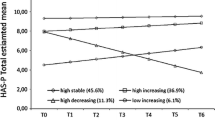Abstract
We assess the utility of looking at the costs/barriers and benefits/incentives of belonging to an Aliance for the Mentally Ill (AMI) self-help group. Support for bimotivational factors of costs and benefits was found. Comparisons were made between members vs. nonmembers and between more active vs. less active members. Implications for theory and application are discussed.
Similar content being viewed by others
References
Backer, T.E., & Richardson, D. (1989). Building bridges: Psychologists and families of the mentally ill.American Psychologist, 3, 546–550.
Battaglino, L. (1987). Family empowerment through self-help groups.New Directions in Mental Health Services, 34, 43–51.
Biegel, D.E., & Yamatani, H. (1986). Self-help groups for families of the mentally ill: Research perspectives. In M. Goldstein (Ed.),Schizophrenia—Patient, family and professional: A new partnership. Family Involvement in the Treatment of Schizophrenia (pp. 57–80), Washington, DC: American Psychiatric Press, Inc.
Bisbee, C.C. (1991).Educating patients and families about mental illness. Frederick, MD: Aspen Publishers, Inc.
Borkman, T. (1984). Mutual self-help groups. In A. Gartner & F. Kriessman (Eds.),The self-help revolution. New York, New York: Human Sciences Press, Inc.
Clark, P.B., & Wilson, J.Q. (1961). Incentive systems: A theory of organizations.Administrative Science Quarterly, 7, 129–166.
Clarke, H.D., Price, R.G., Stewart, M.C., & Krause, R. (1978). Motivation patterns and differential participation in a Canadian party: The Ontario liberals.American Journal of Political Science, 22, 130–151.
Florin, P., & Wandersman, A. (1990). An introduction to citizen participation, voluntary organizations, and community development: Insights for empowerment through research.American Journal of Community Psychology, 18(1), 41–54.
Gidron, B., Chesler, M., Chesney, B. (1991). Cross-cultural perspectives on self-help groups: Comparison between participants and nonparticipants in Israel and the United States.American Journal of Community Psychology, 19(5), 667–681.
Gourash, N. (1978). Help-seeking: A review of the literature.American Journal of Community Psychology, 6, 413–423.
Hatfield, A.B. (1984). The family consumer movement: A new force in service delivery. In Pepper, R., & Ryglewicz, R., Advances in treatment of the young adult chronic patient.New Directions in Mental Health Services, 21, 71–79.
Hatfield, A.B., & Lefley, H.P. (1987).Families of the mentally ill: Coping and adaptation. New York: The Guilford Press.
Hatfield, A.B. (1987). Consumer issues in mental illness.New Directions in Mental Health Services, 34, 35–42.
Hatfield, A.B. (1981). Self-help groups for families of the mentally ill.Social Work, 408–413.
Hatfield, A.B. (1980). The organized consumer movement: A new force in service delivery.Community Support Service Journal, 2, 3–7.
Hatfield, A.B. (1979). The family as a partner in the treatment of mental illness.Hospital and Community Psychiatry, 30, 338–340.
Hollingshead, A.B. (1975). Four factor index of social status. Unpublished manuscipt. Yale University.
Howe, C.W. (1987). The National Alliance for the Mentally Ill: History and ideology.New Directions in Mental Health Services, 34, 23–33.
Jacobs, M.K., & Goodman, G. (1989). Psychology and self-help groups.American Psychologist, 3, 536–544.
Knoke, D., & Woods, J.R. (1981).Organized for action: Commitment in voluntary associations. New Brunswick, NJ: Rutgers University Press.
Knoke, D., & Wright-Isak, C. (1982). Incentive systems: A theory of organizations.Research in the Sociology of Organizations, 1, 209–254.
Levine, M., & Perkins, D.V. (1987).Principles of community psychology: Perspectives and applications. New York-Oxford: Oxford University Press.
Medvene, L.J., & Krauss, D. (1989). Causal attributions about psychiatric disability in a self-help group for families of the mentally ill.Journal of Applied Social Psychology, 19(17), 1413–1430.
Moe, T.M. (1980).The organization of interests: Incentive and the internal dynamics of political interest groups. Chicago, IL: University of Chicago Press.
Olsen, M. (1965).The logic of collective action. Cambridge: Harvard University Press.
Prestby, J.E., Wandersman, A., Florin, P., Rich, R., & Chavis, D. (1990). Benefits, costs, incentive management and participation in voluntary organizations: A means to understanding and promoting empowerment.American Journal of Community Psychology, 18(1), 117–149.
Rich, R.C. (1980). The dynamics of leadership in neighborhood organizations.Social Science Quarterly, 60, 570–787.
Taylor, S.E., Falke, R.L., Shoptow, S.J., & Lichtman, R.R. (1986). Social support, support groups, and the cancer patient.Journal of Consulting and Clinical Psychology, 54, 608–615.
Wandersman, A., Florin, P., Friedmann, R., & Meier, R. (1987). Who participates and why? An analysis of voluntary neighborhood organizations in the United States and Israel.Sociological Forum, 2(3), 534–555.
Author information
Authors and Affiliations
Rights and permissions
About this article
Cite this article
Norton, S., Wandersman, A. & Goldman, C.R. Perceived costs and benefits of membership in a self-help group: Comparisons of members and nonmembers of the Alliance for the Mentally Ill. Community Ment Health J 29, 143–160 (1993). https://doi.org/10.1007/BF00756340
Issue Date:
DOI: https://doi.org/10.1007/BF00756340




